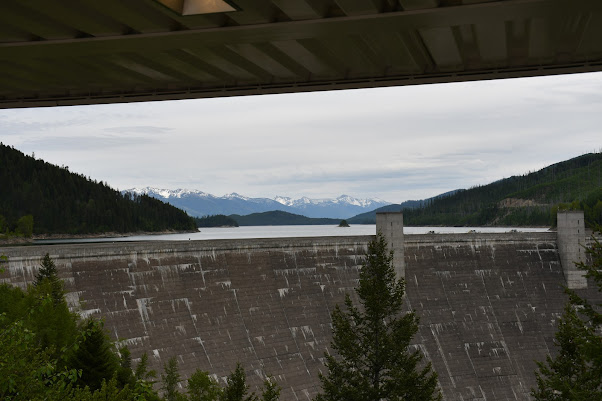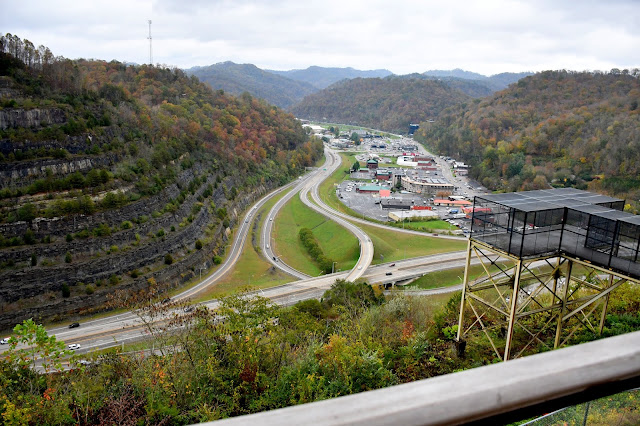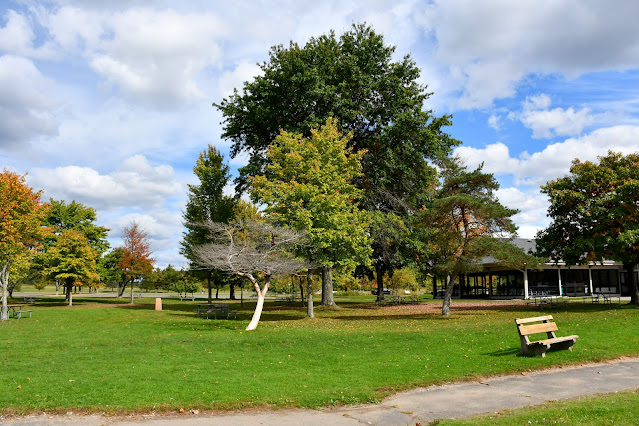Let's Talk About Infrastructure
Let's talk about infrastructure, shall we? Living in the human-built world day in and day out, we often forget that all these buildings, roads, buried pipes, wires, sewers, and literally everything else we build is not actually natural. We require nature - other plant and animal species - for the ecosystem services they provide, but nature does not require our infrastructure. Think about that deeply for a moment and realize that no other species requires our electrical grid - it only serves us, and even we don't truly require it for survival; we got along fine for most ALL of the last 200,000 years or so (except for the last 150 years) without electricity. We *could* get along just fine without it now too, except we went into ecological overshoot. There is now no way to keep industrial civilization humming along without it, and this brings some rather uncomfortable facts to light as shown in this study about our hunter-gatherer future. Unfortunately, civilization itself is unsustainable, so even WITH electricity, we will be unable to keep industrial civilization humming along. In an effort to help explain more about the elctrical grid, please see How Safe, Secure, and Sustainable is the Electrical Grid?
So many people focus on emissions reductions but don't realize that technology use CAN NOT reduce emissions. The only way to reduce emissions is to consume less - less food, less energy, and less products and services across the spectrum. This means reducing technology use. For those who think this is not the case, please go here for the proof. Technology is an illusion not much differently than infrastructure because it literally surrounds us and practically all of our activities and daily living use it. So, learning about technology for anyone who doesn't understand its pervasiveness in today's culture and society is a great idea. Focusing on emissions reductions is a noble idea, but ultimately one that is somewhat misguided. Even if we were to reduce anthropogenic emissions to ZERO right now, climate change would continue mostly unabated with the reduction of harm located timewise into the next centuries. This SOUNDS good for future generations, but unfortunately, the mass extinction we are already in pretty much bakes in a rather unfortunate outcome for those future generations regardless of what we do now. We can attempt to reduce the harm, but our options are pretty much limited to that, quote:
"Most people think that climate change can be "fixed" or reversed, but current science shows that climate change is irreversible on human timescales. Another article shows that this is due to ocean heat uptake (OHU). Another recent study indicates that climate change is irreversible due to permafrost thaw. Still yet another study demonstrates climate change being irreversible due to oceanic oxygen depletion. However, climate change in and of itself isn't the worst part of the overall set of predicaments. It is how climate change and ecological overshoot, its parent predicament, affect the rest of the biosphere and how life on this planet responds to those effects. If all we had to do was adapt to temperatures 2, 3, or 4 degrees Celsius more than today, we could probably accomplish such a task. However, not all plants and animals can say the same, and unfortunately, we depend on far more than just those plants and animals for our own existence; we also depend upon the ecosystem services which they provide. These two articles here and here explain the scenario, but fail to point out that we are actually in at least the 8th mass extinction event (here and here)." ~ taken from Denial of Reality
So, getting back to our topic of infrastructure, what does this mean for the buildings, homes, roads, and infrastructural layers of civilization as time moves forward? Sadly, it means that we are in for a heap of trouble. As that linked article points out, most all of our infrastructure was designed and built for the climate of yesteryear. These next two articles here and here also demonstrate how reinforced concrete, which makes up millions of buildings, dams, bridges, roads, tunnels, and more, will be faring worse over time as climate change creates conditions far less favorable to this building material.
Another misconception that is often made is that we must build all kinds of "clean, green, and renewable" energy devices to power society so we can reduce emissions to help reduce climate change. This is an illusion based upon faulty logic. We cannot build our way out of ecological overshoot, as George Monbiot explains here. What attempting to do so accomplishes is highlighted in this article.
Extreme weather events are already causing serious trouble for thousands of infrastructural installations worldwide. Many disasters and deficiencies focus on dams and bridges, which have been breached due to multiple issues such as glacial lake outbursts, extreme rain events and flooding, poor quality construction and/or inspection, and general deterioration. Every state in the United States has deficient dams and bridges, and many states such as Hawaii contain dams which are almost all in a high risk category. But as these articles point out, these same deficiencies are occurring throughout the world and not just on dams and bridges, either:
Preventing concrete dams from falling apart
Researchers uncover hidden deicer risks affecting bridge health
Estimating the wear and tear of ice on physical structures over coming decades
Crumbling roads, grids cost poor nations billions due to storms
US infrastructure unprepared for increasing frequency of extreme storms
Whaley Bridge dam collapse is a wake-up call
Climate change could hasten deterioration of US bridge infrastructure
Aging US dams pose risk to thousands
Experts explain the effect of climate change on infrastructure
Study finds flooding damage to levees is cumulative - and often invisible
Aging dams pose growing threat: UN
Aging dams are 'ticking time bombs'
Trans-Alaska Pipeline faces increasing threats from floods. Is there a long-term solution?I could go on and on listing many more articles, but as you can clearly see, this is a topic that won't go away anytime soon and as time moves forward, most all infrastructure faces serious issues caused by the increasing wear and tear that climate change will impose upon it. This is a rather serious concern for society in a myriad of ways due to the growing predicament of energy and resource decline. As we slide down the Seneca cliff of collapse (which we are already well into), keeping infrastructure operating safely will become more and more difficult to do. With regards to just the electrical grid alone, this will become a mammoth project which will eventually become what is known as a stranded asset. Another question regarding the electrical grid will be what to do with all the waste created as a result of this attempt at bargaining with the predicament of energy and resource decline instead of accepting it and adapting wisely.
This is what different types of faults and system failures and extreme weather events do to solar panel installations. These systems are far more fragile than most people would ever suspect. As one can clearly see, literally MILLIONS of these devices are decommissioned yearly either due to obsolescence or destruction of one type or another.
The real trouble is that solar panels aren't the only waste management issue; wind turbines come with THEIR waste too. Sadly, the pollution loading caused by not just these devices themselves once erected, but also the waste streams their manufacture and transport and infrastructure required for their use and maintenance is difficult to fathom. Obviously, many wind turbines or specific parts must be decommissioned once their useful service life is over.
The destruction of the entire power grid in Puerto Rico in 2017 due to Hurricane Maria demonstrates just how vulnerable power grids are to extreme weather events. Another extreme weather event in Texas earlier this year in February showed just how unprepared their utility services were there. The same infrastructure had yet more trouble in May and June, proving that the grid there is still not ready for the climate of today.
Think of all the nuclear power facilities operating around the world next to oceans, rivers, and lakes subject to flooding, tsunamis, hurricanes, and other hazards such as earthquakes. Think of all those nuclear plants, many of which depend upon external grid power to keep the pumps running for their cooling pools. Yikes - oops!
Just as imposing of an issue is all the infrastructure located on permafrost, which is now thawing faster and faster year by year:
Research shows Alaska infrastructure at risk of earlier failure
Permafrost Change and Impacts on Infrastructure and Resources in Alaska
A Blessing and a Curse; Melting Permafrost in the Russian Arctic
The fragile future of roads and buildings built on permafrost
Update, 7-28-21: Tim Watkins has added this entry regarding London's water and sewer system which fits nicely into this article.
Update, 8-6-21: This article demonstrates that minor volcanoes could be a serious threat, quote:
"Even a minor eruption in one of the areas we identify could erupt enough ash or generate large enough tremors to disrupt networks that are central to global supply chains and financial systems," said Dr. Lara Mani from CSER, lead author of the latest report."At the moment, calculations are too skewed towards giant explosions or nightmare scenarios, when the more likely risks come from moderate events that disable major international communications, trade networks or transport hubs. This is true of earthquakes and extreme weather as well as volcanic eruption."
This is, unfortunately, just a small sampling of the various publications available on this topic. This particular issue is related to another predicament that is making climate change much worse - natural emissions caused by self-reinforcing positive feedback loops. Permafrost thaw causes increased emissions of carbon dioxide, methane, and other greenhouse gases that multiply the effects already unfolding due to climate change and global heating. Because of these self-reinforcing positive feedbacks, the hotter it gets, the faster it gets hotter. Much more information about permafrost thaw, ice albedo, Arctic ice, polar amplification, and more can be found in this file.
Just like so many other predicaments in today's world, the topics of crumbling infrastructure, asset stranding, and sacrifice/exclusion zones can be added to the list of issues that are insurmountable due to a myriad of conflicting priorities, lack of collective foresight, and energy and resource decline, among other considerations. Live Now!











"no other species requires our electrical grid" -- not true, without the electrical grid 400,000 tons of the most deadly radioisotopes stored in cooling pools at nuclear power facilities will burn unquenchably and all species will be destroyed forever. Thanks for the discussion! Best to you.
ReplyDeleteI repeat, no other species requires the electrical grid. If you go to the Chernobyl site in Russia, you'll notice many different species of plants and animals existing just fine. So, obviously, what I said remains true. I am well aware of the fact that if we wanted to protect the life on this planet, we would decommission every nuclear facility, find a geologically suitable site to store the radioactive waste, and make the attempt to store the waste away from society. Currently, once a site is decommissioned, eventually the fuel rods are dry casked for storage. This could also happen at all the other sites, IF society cared enough about the situation. One cannot justify continuing a system that is destroying life on this planet for selfish reasons. The right things should still be done, as that is a pro-future and sustainable stance.
DeleteChernobyl is a firecracker compared to the 400,000 tons of unsecured nuclear 'spent' fuel that exists on Earth now.
DeleteWhile I agree with your comparison, I don't see how this changes anything. Since the electrical grid CANNOT be maintained long into the future as is pointed out here, the only real option we have is to decommission nuclear facilities now or face the consequences: https://theecologist.org/2021/jul/14/when-climate-breakdown-goes-nuclear
DeleteI find that for a lot of people in denial, it is the time lag between the obvious and immediate 'benefits' of our infrastructure (e.g., new bridge spanning a river that allows more flow to/from an area) and it's increasing maintenance costs (so, an increasing cost/benefit ratio or diminishing returns) that make the connection between 'benefits' and 'costs' so difficult to comprehend and can thereby be leveraged by politicians/developers to rationalise/justify ongoing and increasing development. Mix in the externalisation of 'costs' (e.g., pollutants and ecological destruction of 'far off' places that supply and process material resources, and/or attempt to reclaim or dispose of waste) and it's quite easy for people (especially those pushing such projects/development) to fail to comprehend that such work is not 'cost free' or purely 'beneficial' as the cheerleaders of pursuing the infinite growth chalice repeat ad infinitum. These difficulties in understanding the implications of our pursuit of growth seem next to impossible to uncover for those in denial (particularly given the psychological mechanisms that keep uncomfortable emotions from creating stressful cognitive dissonance).
ReplyDelete